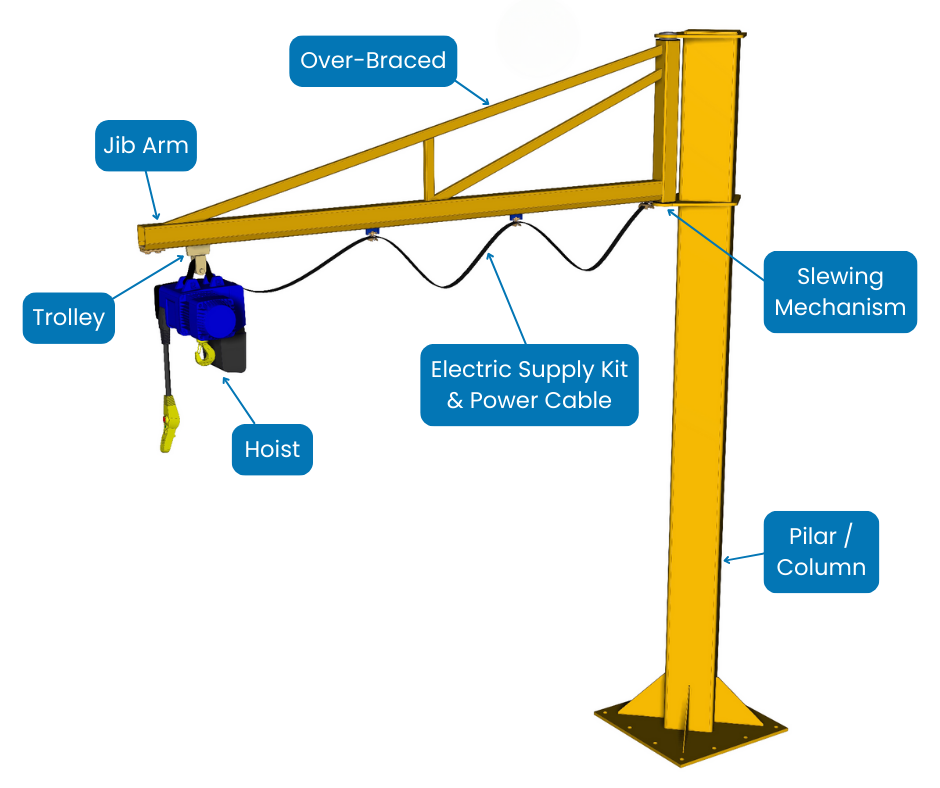What Are Jibs?
When it comes to efficiently moving and lifting loads in a specific work area, you've likely come across the term "jib" or "jib crane." But what are jibs, and how can they benefit your operations? In this guide, we'll demystify jib cranes and explore their various applications.
At its core, a jib crane is a type of overhead lifting device that uses a horizontal jib or boom to support a movable hoist. This jib is typically attached to a vertical mast or a structural building element, allowing it to rotate and cover a circular or semi-circular area. This simple yet effective design makes jib cranes incredibly versatile for a multitude of tasks.
Unlike larger, fixed overhead crane systems that cover an entire factory floor, jib cranes are ideal for localised lifting needs. They are commonly found in individual workstations, manufacturing cells, warehouses, and loading docks, providing a dedicated lifting solution precisely where it's needed.
The Anatomy of a Jib Crane
Understanding the key components of a jib crane helps in appreciating its function:
-
Mast or Column: The vertical support structure that anchors the jib crane. This can be floor-mounted, column-mounted, or wall-mounted.
-
Jib or Boom: The horizontal arm that extends from the mast or support. The hoist travels along this beam.
-
Hoist: The mechanism that lifts and lowers the load. This can be manual, electric, or air-powered.
-
Trolley: A component that travels along the jib, carrying the hoist and allowing for horizontal movement of the load.
-
Rotation Mechanism: Allows the jib to swing or slew, providing coverage of a specific area. The degree of rotation varies depending on the type of jib crane.
Types of Jib Cranes: Finding the Right Fit
Jib cranes come in various configurations to suit different structural possibilities and operational requirements. At ULS Lifting, we specialise in providing robust and reliable jib cranes, including:
-
Free Standing Jib Cranes: These are perhaps the most common type, featuring a mast that is bolted to a substantial concrete foundation. They offer 360-degree rotation and are ideal for open areas where there are no existing structures to utilise. Their self-supporting nature provides excellent flexibility in placement.
-
Column-Mounted Jib Cranes: Designed to be attached directly to an existing vertical support column within a building. This option saves floor space and is a cost-effective solution when suitable columns are available. They typically offer up to 200-degree rotation, limited by the presence of the building column.
-
Wall-Mounted jib Cranes: These cranes are mounted directly onto a reinforced wall or building structure. Like column-mounted jibs, they are excellent for saving floor space and offer a rotation of up to 200 degrees. They are a great choice for maximising usable area within a workshop or facility.
Choosing the right type of jib crane depends on factors such as the available space, the required lifting capacity, the desired area of coverage, and the existing building structure.

The Benefits of Utilising Jib Cranes
Implementing jib cranes into your workflow can bring numerous advantages:
-
Increased Efficiency: By providing readily available lifting power at the point of need, jib cranes significantly reduce the time and effort required for material handling.
-
Improved Safety: Lifting heavy or awkward loads manually poses a significant risk of injury. Jib cranes automate this process, creating a safer working environment for your team.
-
Enhanced Productivity: Faster and safer lifting operations lead directly to increased productivity and throughput.
-
Cost-Effective: For localised lifting tasks, jib cranes are often a more economical solution compared to larger overhead crane systems.
-
Space Saving: Wall-mounted and column-mounted jibs, in particular, free up valuable floor space.
-
Versatility: With various types and capacities available, jib cranes can be tailored to a wide range of applications and industries.
Beyond the Crane: Accessories and Support
To maximise the functionality and safety of your jib crane, consider the range of accessories and support systems available. This can include various types of hoists and trolleys, as well as festoon systems and remote control systems for enhanced operator control and safety. Furthermore, ensuring you have access to reliable crane and hoist spare parts is crucial for maintaining your equipment and minimising downtime.
Find Your Ideal Jib Crane Solution with ULS Lifting
Now that you have a clearer understanding of what jib cranes are and how they can benefit your operations, why not explore the possibilities for your workplace?
At ULS Lifting, we offer a comprehensive range of high-quality Free Standing, Column Mounted, and Wall Mounted Jib Cranes, along with the necessary accessories and spare parts to keep your lifting operations running smoothly. Our expert team is on hand to help you select the perfect jib crane solution tailored to your specific needs and requirements.
Ready to improve your lifting efficiency and safety? Browse our extensive range of jib cranes and accessories today!
